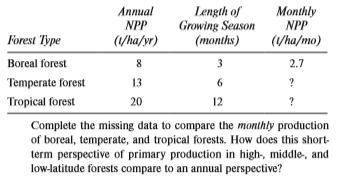Question
1. Population, community, and ecosystem ecologists study structure and process. However, they focus on different natural characteristics. Contrast the important structures and processes in a
1. Population, community, and ecosystem ecologists study structure and process. However, they focus on different natural characteristics. Contrast the important structures and processes in a forest from the perspectives of population, community, and ecosystem ecologists.
2. M. Huston (1994b) pointed out that the well-documented pattern of increasing annual primary production from the poles to the equator is strongly influenced by the longer growing season at low latitudes. The following data are from table 14.10 in Huston. The data cited by Huston are from Whittaker and Likens (1975).

3. Many migratory birds spend approximately half the year in temperate forests during the warm breeding season and the other half of the year in tropical forest. Given the analyses you made in question 2, which forest appears to be more productive from the perspective of these migratory birds?
4.Field experiments demonstrate that variation in soil fertility influences terrestrial primary production. However, we cannot say that nutrients exert primary control. That role is still attributed to temperature and moisture. Why do ecologists still attribute the main control of terrestrial primary production to temperature and moisture? Consider the difference in primary production between arctic tundra and tropical forest
(see fig. 18.2) and the extent to which nutrient additions (Shaver and Chapin 1986) changed primary production in tundra.
5.Compare the pictures of trophic structure that emerged from our discussions of food webs in chapter 17 with those in chapter 18. What are the strengths of each perspective? What are their limitations?
6. Suppose you are studying a community of small mammals that live on the boundary between a riverside forest and a semidesert
grassland. One of your concerns is to discover the relative
contributions of the grassland and the forest to the nutrition of small mammals living between the two ecosystems. Design a research program to find out. (Hint: The grassland is dominated by C4 grasses and the forest by C3 plants.)
7.In chapter 17, we examined the influences of keystone species on the structure of communities. In chapter 18, we reviewed trophic cascades. Discuss the similarities and differences between these two concepts. Compare the measurements and methods of ecologists studying keystone species versus those studying trophic cascades.
8. The studies of nutrient limitation of aquatic primary production that we reviewed focused almost entirely on lakes within the temperate zone. Suppose you are an ecologist interested in determining whether primary production in tropical lakes is subject to similar control by nutrient availability. Design a study to find out what controls rates of primary production in tropical lakes. Use all the sources of information at your disposal, including published research, surveys of natural variation, and large- and small-scale experiments.
Step by Step Solution
3.37 Rating (163 Votes )
There are 3 Steps involved in it
Step: 1

Get Instant Access to Expert-Tailored Solutions
See step-by-step solutions with expert insights and AI powered tools for academic success
Step: 2

Step: 3

Ace Your Homework with AI
Get the answers you need in no time with our AI-driven, step-by-step assistance
Get Started


